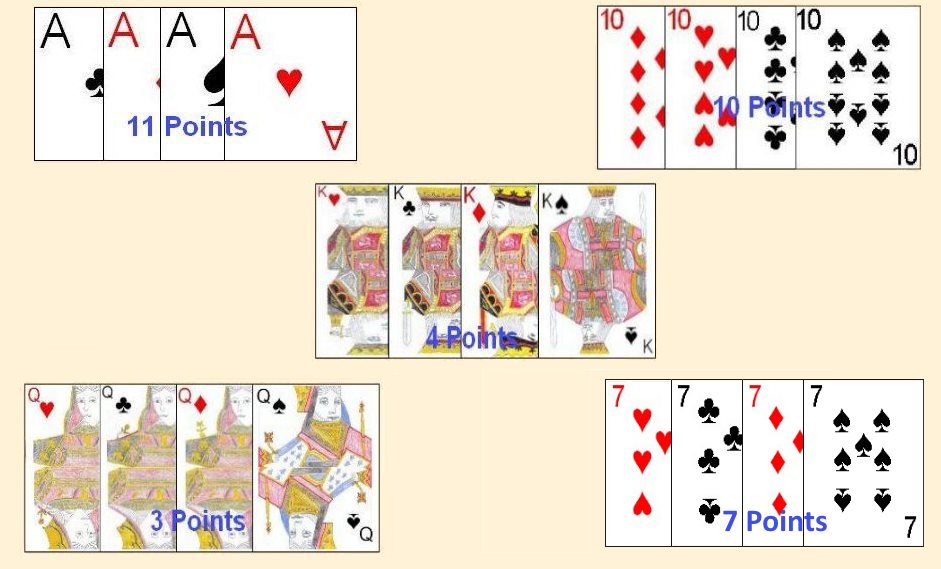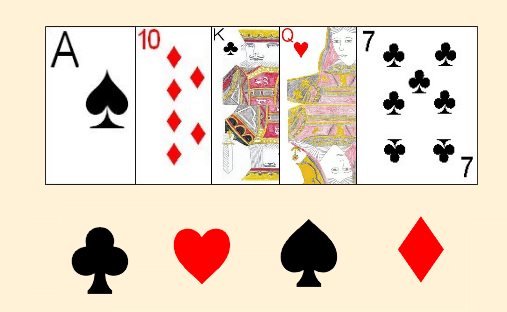Several additions or changes have been added by some players including several suggested by Sid Sackson in his groundbreaking book. The following are some of these changed or additional rules sometimes added to this game:
Discarding: Some players replace the foreplacing a card with the concept of discarding. Thus, players do not have the option to foreplace a card at the beginning of the hand. However, they do have the opportunity to discard, at the beginning of any turn.
Thus, either player, at the beginning of his turn announces he wants to discard a card. He then exposes the card he intends to discard to his opponent and then places the card face-down in front of himself. This card will have no further part in the current hand. After discarding a card, the player must then make his normal move. A player may only discard one card during a turn and is never required to do so.
The difference between discarding and foreplacing are as follows.
Foreplacing can only be done before the first move of the hand, while
discarding can be done at the start of any hand. Because of this, a
player may end up with much fewer than 10 cards in hand. If a player
runs out of cards during the hand while his opponent still has cards, he
is considered to use his last played card to each remaining trick.
As an example, suppose a player were to win the win the game on the
eighth turn, with a King and having discarded one card. His total
score for the hand would thus be 36. Four points as the winning
card (King) multiplied by the value of the turn number (eight) added to
the number of discards (1), for a total of 36 poinsts for the hand.
Scoring and Overmate Multiplier: As in the standard variant, the score for a player is based on the card value of the card used to win the hand
multiplied by the sum of ordinal number of the trick on which he was able to win the hand added to the number of discarded cards that player made during the hand.
In addition, a player is entitled to additional multipliers if he manages perform an overmate (winning the hand on a trick in which he had to re-use a previous card because he has no cards remaining in hand), the player is allowed to add an additional amount to the final multiplier. This bonus is based on the ordinal trick number of player's win + total discards by the player. This number is then used to determine an additional bonus that can be added to the
multiple. The following chart shows the amount of the multiplier depending on this total:
| OverMate Trick Number | Overmate Multiplier |
|---|
| 1 | 2 |
| 2 | 3 |
| 3 | 4 |
| 4 | 5 |
| 5 | 6 |
In all other aspects this game is played identically to the standard variant.
King's Privilege: Another optional rule that is sometimes added is that of King's Privilege
(also sometimes called Queens Privilege, after the most powerful piece
on a Chess board). In this rule, when a player leads an Ace to a trick that player may (but is not required to) declare "King's Privilege". If he does so announce this, his opponent must play another Ace to the trick (if he has one). If he does not have one, he may play another card of the same suit as usual.
Copyright © 2015 CatsAtCards.com. All rights reserved.

 Each card can be thought to represent a piece from a Chess set, and has a relative ranking. The ranking of the cards in the deck are as follows (from high to low): Ace, 10, King, Queen, 7. As between cards of the same denomination each suit also has a relative ranking. The ranking of the suits used in this game are as follows (from high to low); Clubs, Hearts, Spades, Diamonds.
Each card can be thought to represent a piece from a Chess set, and has a relative ranking. The ranking of the cards in the deck are as follows (from high to low): Ace, 10, King, Queen, 7. As between cards of the same denomination each suit also has a relative ranking. The ranking of the suits used in this game are as follows (from high to low); Clubs, Hearts, Spades, Diamonds.

